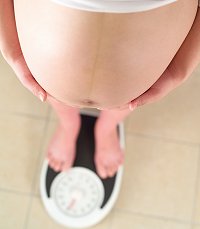 There is an unfortunate new bar being raised when it comes to pregnancy weight gain. Pregorexia is a relatively new phenomenon in which moms-to-be gain very little weight throughout their entire pregnancy and return to their pre-pregnant weight within just a few days of giving birth.
There is an unfortunate new bar being raised when it comes to pregnancy weight gain. Pregorexia is a relatively new phenomenon in which moms-to-be gain very little weight throughout their entire pregnancy and return to their pre-pregnant weight within just a few days of giving birth.
Pregorexia is affecting more and more American women who choose to eat as little as possible during pregnancy out of fear of gaining weight. With celebrities like Angelina Jolie and Nicole Kidman, who maintained a very thin figure throughout their pregnancy and reclaimed their pre-baby body in very little time, the spotlight on such high-profile women may be putting other women at risk for developing this disorder.
The health ramifications of this condition for both the mother and unborn child cannot be underestimated. Drastically reducing calories during pregnancy has been linked to low baby birth weight, birth defects like spina bifida, growth retardation and a host of vitamin and mineral deficiencies affecting mother and child.
Since pregorexia is such a new condition, very little epidemiological data exists on the prevalence of it. But a few important research studies discuss the prevalence of eating disorders in pregnant women and the risk factors of being anorexic while also being pregnant. Most of the research comes from the United Kingdom, where pregorexia has received more attention than here in the U.S.
According to Tommy’s, the British organization that funds research on pregnancy, pregnancy complications and prenatal education, two percent of all pregnant women in the UK suffer from eating disorders.
Many gynecologists and obstetricians are clinically aware of tell-tale signs of anorexia or bulimia but very few of them know what questions should be asked to an expectant mother who has a history of an eating disorder or is showing the hallmark signs of pregorexia such as slow or gradual weight gain or excessive exercise. According to the Remuda Ranch Programs for Eating Disorders, one of the nation’s leading eating disorder treatment centers, eating disorders are increasing in women of childbearing age. They estimate that four percent of child-bearing women have an eating disorder.
Hopefully as more awareness is generated around pregorexia, additional research and education will be done so that medical and health professionals and moms-to-be can understand the signs, risks and best preventive means to address this disorder.
